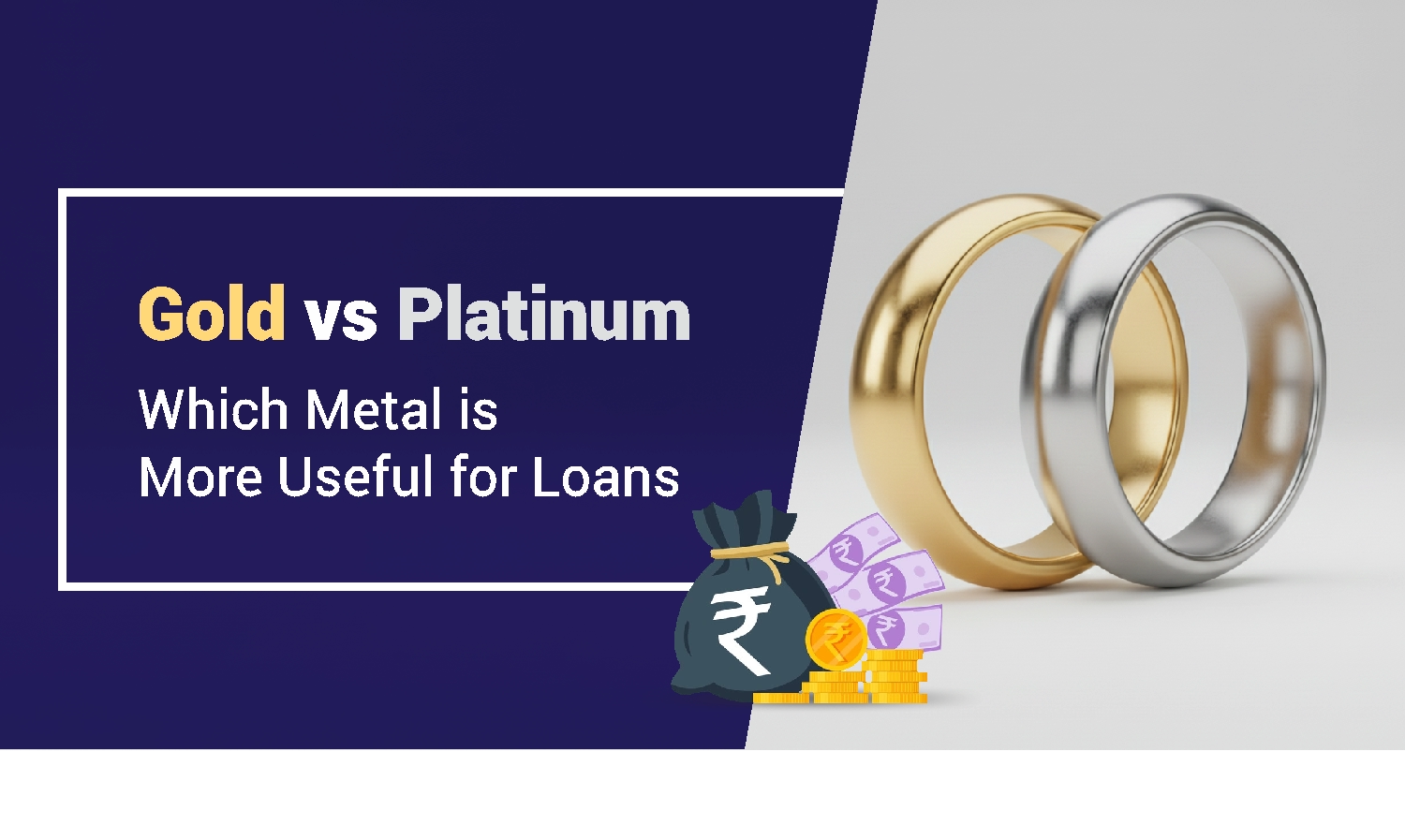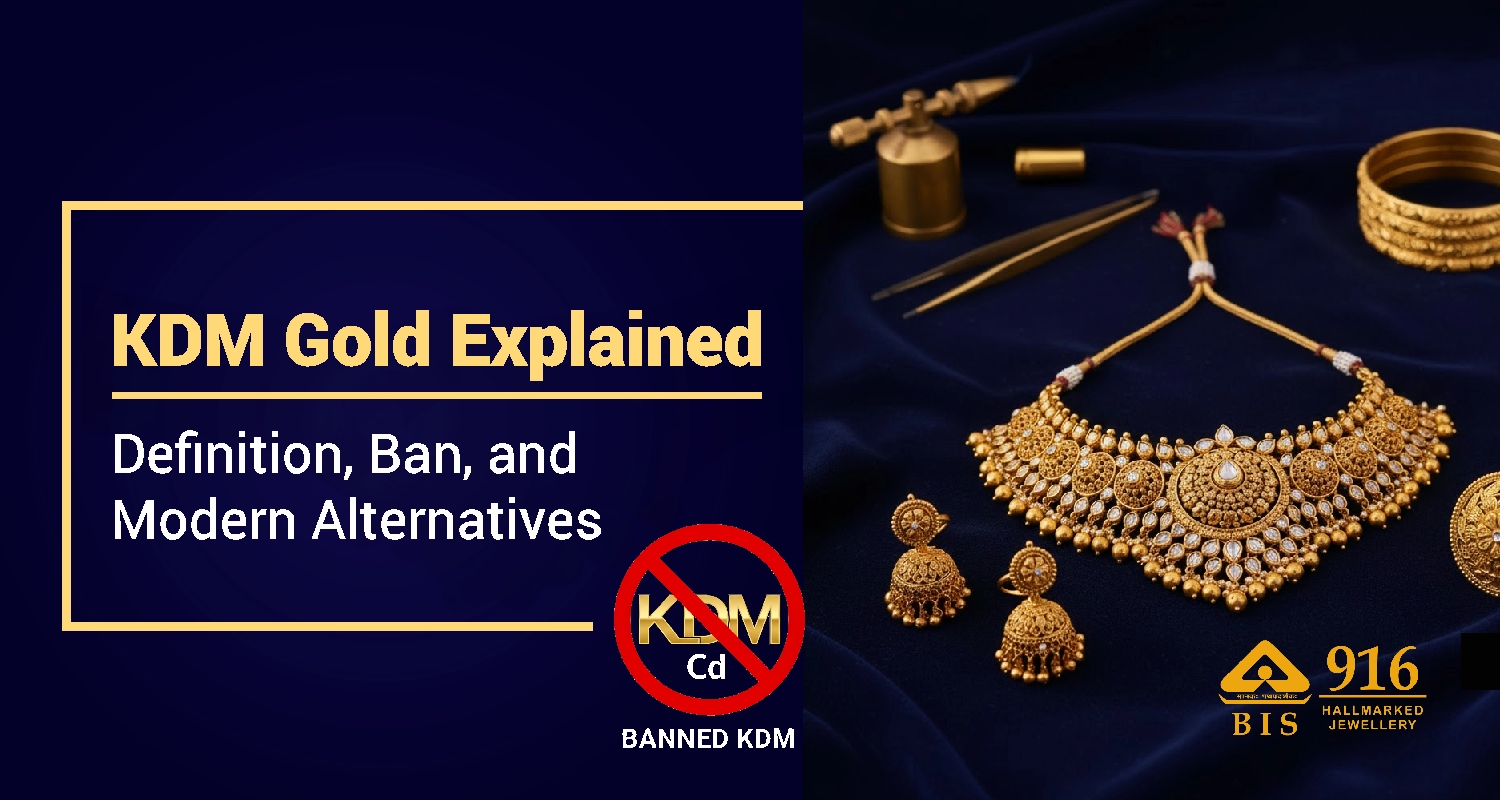Gold vs Platinum: Which Metal is More Useful for Loans

The worldwide market value of gold and platinum remains high, but India uses these precious metals for purposes that go beyond jewellery making and financial speculation. They are wealth indicators and security symbols although they possess distinct chemical properties.
When it comes to comparing gold vs platinum, one common question arises, which is better gold or platinum for loans, jewellery, and investment?
Gold dominates the lending landscape thanks to its high liquidity, established market pricing, and wide acceptance among banks and NBFCs. Platinum lacks the same recognition as collateral, making gold the preferred metal when seeking loans or quick financial support.
Price Comparison: Gold vs Platinum in India
When comparing which is costly, gold or platinum in India, gold remains far more expensive than platinum despite both being classified as precious metals.
Is gold costly or platinum? The current market shows 24K gold costs ₹12,448 per gram, but platinum sells for ₹4,584 per gram throughout major Indian cities including Mumbai, Delhi and Kolkata.
Factors Influencing Price Differences
- In India, gold’s value stems from multiple elements which include:
- People in India continue to buy gold for making jewellery and to give as gifts during religious events and special occasions.
- People in India use gold as their primary savings vehicle and loan security.
- The market offers high liquidity through its deep secondary trading segment.
Why Is Gold Costlier than Platinum in India?
While platinum is rarer and often more valuable in several Western markets, in India, gold’s cost is consistently higher because:
- Cultural importance and established market infrastructure make gold highly liquid.
- Bank and NBFC acceptance for loans is built around gold, increasing its real-world utility.
- Platinum’s investment and collateral acceptance remain minimal, restricting its price momentum and perceived value.
Why is Platinum Sometimes Cheaper than Gold?
Why is platinum cheaper than gold even though it is rarer? The core reason is differing demand profiles.
Gold enjoys consistent, high demand as a safe-haven asset and for jewellery, maintaining strong investment flows globally. Platinum, on the other hand, depends heavily on industrial demand, especially in automotive catalytic converters, making its price sensitive to economic slowdowns and shifts in manufacturing.
Platinum’s supply chain adds further volatility, as most mining occurs in South Africa and Russia, where strikes, regulatory issues, or delivery disruptions can affect output. In contrast, gold’s geographically diverse mining base ensures steady supply and stable pricing.
Investor perception also drives the gap. Gold is more liquid, widely accepted, and viewed as a core investment and collateral asset, particularly in India. Platinum’s smaller, industrial-focused market lacks similar investor confidence. This is why the answer to is platinum expensive that gold is No.
Durability and Maintenance: Which Metal Lasts Longer?
When it comes to durability and longevity, is platinum better than gold? Platinum generally outperforms gold, particularly for everyday jewellery like rings and bangles.
- Scratch Resistance and Surface Wear
Platinum is denser and more durable than gold, making it ideal for jewellery that experiences frequent wear. It does scratch, but the metal is displaced, not lost, developing a natural matte patina over time, which many wearers appreciate. - Gold, while strong, is softer and loses tiny metal particles when scratched or polished. The softness of higher-karat gold increases with purity, though 14k gold remains relatively hard.
- Maintenance and Care Requirements
White gold needs regular rhodium plating every 1 to 3 years to maintain its white colour. Platinum maintains its natural white tone without replating, requiring only occasional polishing for a glossy finish. Most platinum owners embrace its patina, reducing upkeep. - Hypoallergenic Properties
Platinum is highly hypoallergenic and suitable for sensitive skin, as it is almost entirely pure and free from nickel or copper alloys. Gold can cause reactions in some people, especially if it contains nickel. - Quick Comparison: Platinum vs Gold Durability
Platinum: More durable, denser, forms a natural patina, rarely needs replating, hypoallergenic.
Gold (Yellow/White): Softer, may lose material, white gold needs replating, some alloys may cause allergies.
Best for Longevity: Platinum outlasts gold in heavy-use jewellery and suits sensitive skin.
Loans Against Gold vs Platinum - Which is More Useful?
When it comes to gold vs platinum loans, in India, gold loans are among the most popular and accessible secured lending products, offered by nearly all banks, NBFCs, and fintech firms. The benefits of a gold loan include high liquidity, cultural importance, and an established resale market, making it the preferred option for lenders and borrowers alike.
Loans against platinum are rare, with limited availability, low market acceptance, and few lenders willing to accept platinum as collateral.
Why Gold Loans Dominate in India
- Popularity: Gold loans dominate because most households own gold jewellery easily used as collateral.
- Ease and Acceptance: Minimal documentation, fast approval, and wide acceptance make gold loans the default choice for quick funding.
- Market Value: Lenders offer up to 75% of gold value (LTV ratio), with gold loan amount per gram vs platinum loan amount adjusting to market prices.
- Interest Rates: Gold loan rates (as of October 2025) range from 8.05% to 17% at banks and 15–22% at NBFCs.
Platinum as Collateral: Rarity and Constraints
- Limited Market: Only a few niche lenders may accept platinum jewellery.
- Lower Loan Amount per Gram: Platinum’s value is lower, so loan amounts per gram are smaller.
- Higher Rates: Where available, interest rates are higher due to volatility and limited resale options.
Loan Amount and Eligibility Comparison Table
|
Parameter |
Gold Loan (India, 2025) |
Platinum Loan |
|
LTV Ratio |
Up to 75% |
Up to 70% (rare cases) |
|
Loan Amount per gram |
₹9,000 – ₹12,000 |
₹3,000 – ₹4,500 |
|
Accepted Purity |
18K – 24K |
95%+ |
|
Approval Time |
Same day/Instant |
Delayed/Case by case |
|
Interest Rate (typical) |
8% – 17% (Banks), 15–22% (NBFCs) |
15%+ (if available) |
|
Lender Availability |
Banks, NBFCs, Fintechs |
Some jewellers/NBFCs |
Which Metal is Better as Collateral?
Gold is more useful for loans in India due to its higher value, broad acceptance, lower rates, and quick processing. Platinum remains a niche collateral with lower liquidity and higher borrowing costs.
Investment Potential: Gold vs Platinum
When it comes to gold investment and platinum investment, both metals offer distinct advantages. You need to compare platinum vs gold investment to understand which offers better long-term stability.
Gold is prized as a stable safe-haven asset, while platinum’s value is influenced more by industrial demand and volatility. Although platinum is rarer, in most market cycles, the answer to is platinum costlier than gold is no, since gold maintains stronger and more consistent demand in India.
Stability and Volatility
Gold’s price tends to move steadily upward or hold value during crises, inflation, and market downturns.
The market value of platinum shows high volatility because it rises rapidly when industrial needs increase but falls rapidly when industrial needs decrease or when new technologies emerge or supply levels change.
Liquidity and Resale Value
Gold is easily traded and sold across Indian and global markets, with rapid liquidity and minimal price discrepancies.
The value of platinum restricts investors from easily selling their assets because the market remains small which extends their time needed to convert their investments into cash.
Asset Choice for Different Goals
Gold is ideal for conservative investors, long-term savings, and those seeking protection against inflation and economic shocks.
Platinum attracts those looking for contrarian bets, exposure to industrial cycles, or seeking higher short-term gains but comes with more risk and uncertainty.
Case Study: 2025 Performance
In the first half of 2025, platinum outperformed gold, surging by nearly 57% year-to-date thanks to supply deficits and robust demand, while gold gained about 25% in the same period. However, analysts expect gold’s steady price to remain supported, while platinum’s future depends heavily on mining output, shifts toward electric vehicles, and adoption in hydrogen technologies.
Summarizing this, gold remains the clear favourite for stability, liquidity, and value retention, especially for Indian investors. Platinum can offer outsized returns in select windows — but those looking to minimize risk and maximize wealth preservation should continue to rely on gold for most investment strategies.
Jewellery Considerations: Choosing Between Gold and Platinum
Jewellery buyers often compare gold vs platinum jewellery when choosing between the two. Both metals are luxurious, durable, and symbolically valuable, but differ in purity, weight, and maintenance.
|
Feature |
Gold Jewellery |
Platinum Jewellery |
|---|---|---|
|
Purity (common) |
58%-99.9% (Karat-based) |
90–95% |
|
Weight |
Lighter |
Heavier (≈11% denser) |
|
Color Options |
Yellow, white, rose |
Only natural white/silver |
|
Scratch Resistance |
Moderate (hard alloys) |
High (doesn't lose volume) |
|
Tarnish |
Minimal on pure gold, but white gold loses plating |
Develops natural patina |
|
Maintenance |
Needs polishing/rhodium |
Low; restore shine easily |
|
Hypoallergenic |
May cause allergy if alloyed (e.g., nickel) |
Hypoallergenic |
|
Cost per gram |
Lower (see section above) |
Higher due to rarity |
|
Lifetime Value |
High resale, easy to sell |
High resale, retains value |
So, is platinum better than gold? It often comes down to how the jewellery will be used. Platinum is stronger and more resistant to wear, making it ideal for daily-use items such as rings and bangles. It also retains its natural colour and finish longer than gold, which requires replating or polishing over time.
As for platinum or gold which is costly for jewellery, platinum jewellery usually has a higher upfront cost because it is denser and purer, requiring more metal to craft a single piece. However, gold often retains better resale value in India due to its widespread demand, cultural importance, and market liquidity.
How to Choose Between Gold and Platinum in India?
When deciding which is better gold or platinum, your choice depends on your goals and preferences.
For investment or resale value, gold is better than platinum because it offers greater liquidity and acceptance.
- For loans or collateral, gold is universally recognized and easier to pledge.
- For durability and everyday wear, platinum’s scratch resistance helps it last longer.
- For skin sensitivities, platinum is ideal, as it is hypoallergenic and rarely causes irritation.
- For colour preferences or ring styles, gold provides more variety (yellow, white, rose).
- For budget buyers, gold usually costs less per gram.
Decision Guide
- Prefer gold if you want easy resale and more colour choices.
- Prefer platinum if you prioritize durability or have metal allergies.
- For jewellery you plan to wear daily, platinum offers longer-lasting brilliance, while gold offers affordable luxury.
Is platinum better than gold? The above points should help answer this question.
Frequently Asked Questions
Platinum jewellery often costs more due to purity and rarity, but gold generally has a higher spot price per gram, better resale value, and broader global investment demand.
Gold is more liquid, widely accepted by lenders, and has a deeply established market structure for loans, offering easier processing, higher loan amounts, and quicker fund disbursal.
Platinum needs less maintenance but develops a patina; white gold needs periodic rhodium replating to maintain its bright finish, especially with frequent or everyday use.
Platinum is rarely accepted as loan collateral due to limited market familiarity, fewer lending institutions, and almost no standardised resale or valuation process available.
Lower demand for platinum jewellery, industrial dependencies, and fewer lending or market avenues keep platinum’s price below gold’s in most seasons and market conditions.
Disclaimer : The information in this blog is for general purposes only and may change without notice. It does not constitute legal, tax, or financial advice. Readers should seek professional guidance and make decisions at their own discretion. IIFL Finance is not liable for any reliance on this content. Read more



